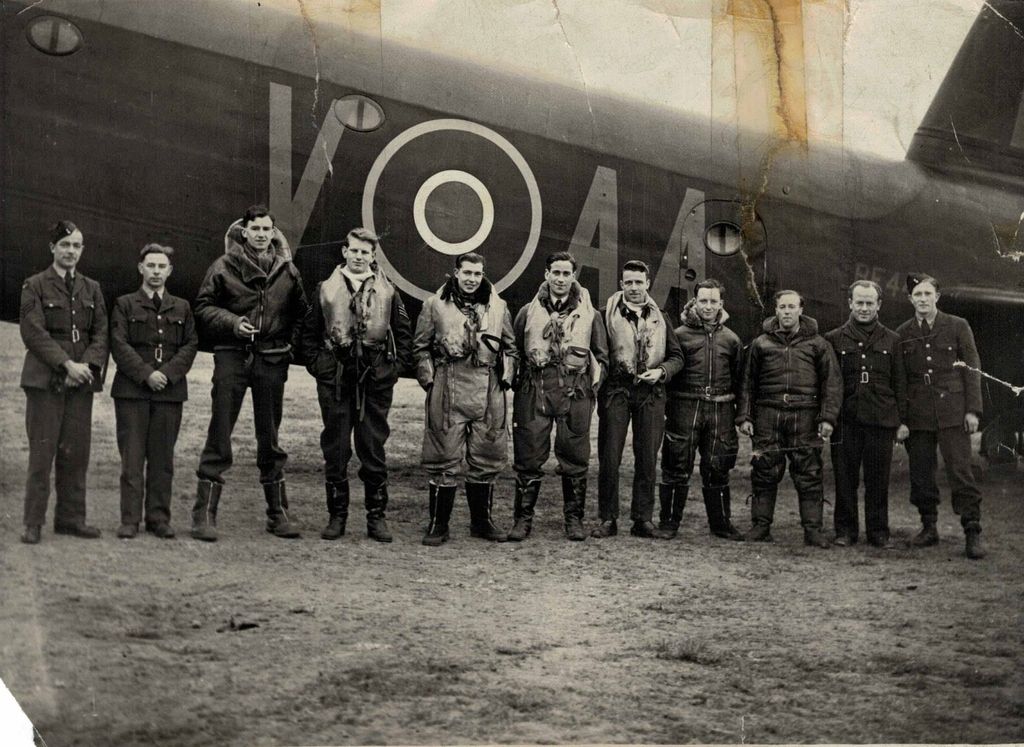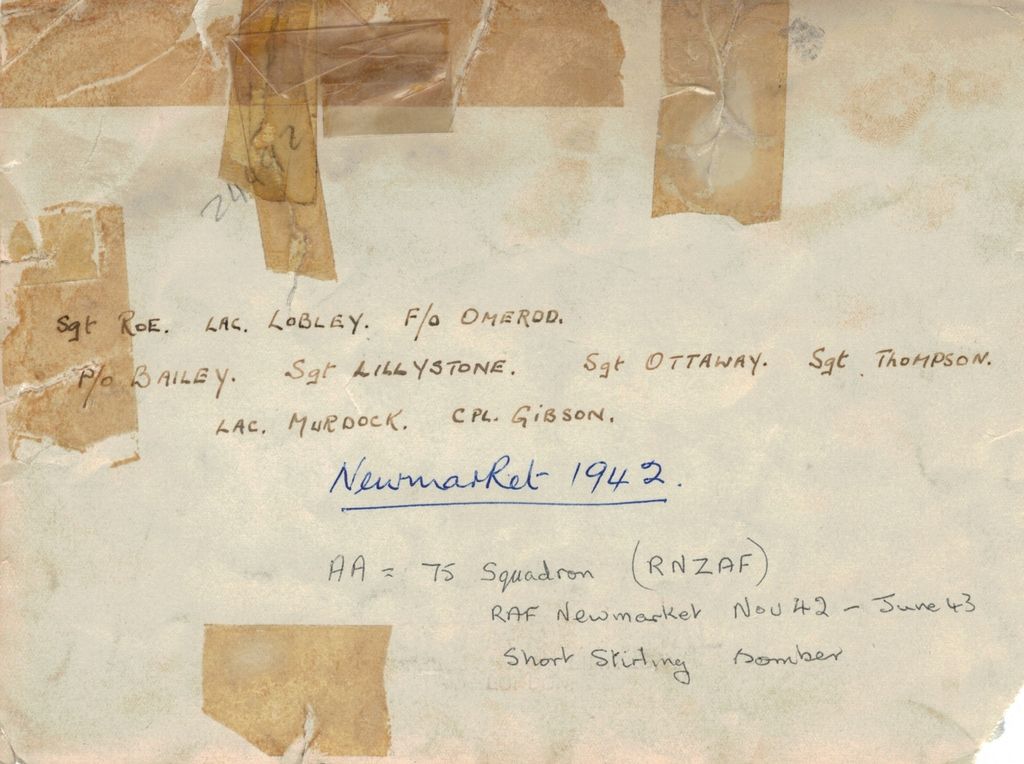|
|
Post by fwx on Aug 22, 2014 11:06:02 GMT 12
Yes, back to 75! Don, your very first photo posted above, the 75 (NZ) Sqdn wall in Chequers pub - did you realise that the large framed Lancaster picture has a whole stash of 75 (NZ) Sqn signatures on the back? Hope Simon doesn't mind me stealing his thunder, but he was the one who found this out, only a week or two after you were there. Apparently the picture was presented by the Egglestone crew in 1983, and was subsequently used to gather signatures from visiting 75-ers. Some very famous and familiar names!
|
|
|
|
Post by Dave Homewood on Aug 22, 2014 13:48:29 GMT 12
Don should have signed it! He's a very famous 75'er himself.
|
|
|
|
Post by pjw4118 on Aug 22, 2014 14:56:33 GMT 12
Thanks Don . That publican must now be getting a complex with all these Kiwis arriving , whipping the pictures off the wall , then taking off. He told me the ceiling was repainted in the 1960s covering the signatures, so who ever goes next take some paint stripper.
|
|
steve218
Warrant Officer
 No.218 (Gold Coast) Squadron Association Historian & No.623 Squadron Researcher
No.218 (Gold Coast) Squadron Association Historian & No.623 Squadron Researcher
Posts: 40 
|
Post by steve218 on Jul 24, 2015 9:04:05 GMT 12
While cross checking photos and logbooks from 75 Squadron I wondered why this unit held onto its Stirlings for so long , into April 1944 ? While most others had converted much earlier. The 456 NZ aircrew KIA on 75 was the highest rate in the Group and their outdated Stirlings were certainly not given soft targets and were not really up to the task given them. Was 75 the last RAF BC heavy squadron to operate them.?? Any thoughts ?/ Hi Pete,
In answer to your questions, No.149 (East India) Squadron was the last main force squadron to operate the Short Stirling in a purely bombing role. No.218 (Gold Coast) was the second from last, both squadrons converted to the Avro Lancaster during August / September 1944.
No.3 Group, of which No.75(NZ) Squadron was part, put in place a conversion table, it was called the "Ladder Plan". Each squadron within No.3 Group was given a date in which it was programmed to convert from the Stirling to the Lancaster. As each squadron converted, each of the squadrons following went up one rung, once at the top, it converted. The delay in No.3 Groups conversion over to the Lancaster was primarily the result of the heavy losses during the Berlin campaign of 1943/44. Such was the loss rate within the ranks of Bomber Commands Lancaster squadrons ( who towards the end were primarily the main type used ) it was only just possible to keep up production of the aircraft to meet operational demands. These "new" Lancaster's were used to replace those lost on existing Lancaster equipped squadrons. These heavy losses continued up to and beyond the Invasion. I have a document via the NA which originally envisaged No.3 Group being totally converted over to the Avro Lancaster by March 1944. As it was, it over run by 5 months.
Cheers
Steve
|
|
|
|
Post by fwx on Jul 24, 2015 16:43:52 GMT 12
Thanks Steve, good information to know. I've also wondered why it took so long; it seems like 75 (NZ) Sqdn was "treading water" for a while, hamstrung by the limitations of their Stirlings. Cheers, Chris
|
|
|
|
Post by pjw4118 on Jul 24, 2015 17:37:09 GMT 12
I do know that the CO of 75 was very frustrated and appealed to the NZ High Commissioner Bill Jordan and as a result (I have ? seen ?) a letter from him to the Air Ministry questioning the hold up . From memory he asked " when will one of the RAFs premier bomber squadrons be issued with up to date equipment as used by other squadrons rather than being relegated to second line duties." By this I assume was mining. I do know that six weeks later Lancs started to appear at Mepal. Perhaps getting them earlier would have meant fewer casualties and a higher bomb tally. I will try to find the letter , as it was fairly blunt.
|
|
steve218
Warrant Officer
 No.218 (Gold Coast) Squadron Association Historian & No.623 Squadron Researcher
No.218 (Gold Coast) Squadron Association Historian & No.623 Squadron Researcher
Posts: 40 
|
Post by steve218 on Jul 25, 2015 0:22:56 GMT 12
Hi Pete,
I am not sure if getting the Lancaster earlier would have reduced the casualties. If, and its a big if, 75(NZ) would have converted during the winter of 1943/44 it would have participated in the debacle that was the Berlin campaign. You only have to compare the loss rate with 115 & 514 Squadrons (both 3 Group) to see an alarming trend in operational losses. Granted, they were flying the Hercules equipped Mk.II. On 218 Squadron, the general opinion from those who were operational at this time was, the delay in conversion resulted in them completing a tour!
|
|
|
|
Post by Dave Homewood on Jul 25, 2015 2:09:50 GMT 12
The Mk II Lancaster with Hercules engines apparently had a better climb rate and a higher speed than the Merlin engined Mk I and Mk III model Lancasters. Not surprising when you compare the Rolls Royce Merlin XX engines were 1,280hp each () whereas the Bristol Hercules VI used in the Lancaster II each developed 1,650 hp (1,230 kW). Some Lancaster II's actually had the even more powerful Hercules XVI.
Plus I'm sure the radial engine worked better when hit by flak than a Merlin did.
|
|
steve218
Warrant Officer
 No.218 (Gold Coast) Squadron Association Historian & No.623 Squadron Researcher
No.218 (Gold Coast) Squadron Association Historian & No.623 Squadron Researcher
Posts: 40 
|
Post by steve218 on Jul 25, 2015 6:18:14 GMT 12
Hi Dave,
In my opinion I prefer the Mk.II over the Mk.I & II for the very reasons you state. However, sadly the losses suffered by 115 & 514 are grievous during the winter of 1943/44.
Steve
|
|
|
|
Post by Dave Homewood on Jul 25, 2015 10:47:09 GMT 12
I wonder why it was the case that losses were higher then. The Hercules was a good and reliable engine, and the only difference for the pilot is they had an extra lever for manual mix control I believe. In theory it should have been a superior version of the bomber. Was it just plain bad luck they were sent on the worst raids for heavy defences?
|
|
|
|
Post by baz62 on Jul 25, 2015 15:25:09 GMT 12
Plus I'm sure the radial engine worked better when hit by flak than a Merlin did. Probably more that the Merlin's cooling system could be damaged by flak/night fighters whereas the radial didn't need one as it was aircooled. |
|
|
|
Post by pjw4118 on Aug 19, 2015 9:04:28 GMT 12
This photo has been sent to the NZBCA by a lady in Lincoln. Her father Fred Lobley appears in the picture. They wonder what happened to F/O Omerod "a lovely gentleman" and where are they all now. The ladies five brothers all came home safely and she now wonders about the kiwis. Any comments most welcome   |
|
|
|
Post by Dave Homewood on Aug 19, 2015 11:24:47 GMT 12
The captain in this crew was Pilot Officer (later Sqn Ldr.) John Mathers Bailey, DFC*, RNZAF, (NZ412183). He died on the 2nd of November 1967 in Lower Hutt.
Other aircrew members here are:
Flying Officer (later Sqn Ldr) Charles Fray Ormerod, DFC, mid RNZAF. (NZ413340) Observer/Navigator
Sgt T.E. Lillystone RAF, (941925) Flight Engineer
Sgt F.J. Ottaway RAF. (1284470, WOp-AG) Front Gunner
Sgt W.F. Thompson RAF. (962902, AG) as Rear Gunner.
Three of the men are ground crew;
Sgt Roe RAF (1083131) Fitter 2A
Cpl J. Gibson RAF (1372700) Fitter 2E ‘B’ Flt
LAC R. Murdoch RAF. (984666) FMA ‘B’ Flt
S/Ldr Charles Ormerod stayed in the RNZAF postwar, flew a short time on secondment to BOAC and then served with No. 41 Squadron on Dakotas, and became RNZAF Station Whenuapai's Navigation officer 1947-1949. He left the RNZAF 18th of August 1949. He died on the 8th of December 2003, aged 83.
LAC Lobley remains a mystery but he must have been ground crew I guess.
|
|
|
|
Post by fwx on Aug 19, 2015 14:20:53 GMT 12
|
|
|
|
Post by pjw4118 on Aug 19, 2015 17:09:59 GMT 12
Thanks gentlemen. Chris "fourth to left " is that "fourth from left "?
|
|
|
|
Post by fwx on Aug 20, 2015 10:06:19 GMT 12
"From", "to", gee you're getting picky Peter ..! Yes, Bruce Hosie is the fourth person along, counting from left to right ...
|
|
|
|
Post by pjw4118 on Aug 25, 2015 13:45:03 GMT 12
Chris , my wife is Irish so I always check which left she means today.
|
|
|
|
Post by pjw4118 on Aug 25, 2015 13:53:34 GMT 12
Chris , Is the Stirling BF 443 ? What did happen to it , any idea , I have a delivery of 2/2/43
|
|
waynem
Pilot Officer

Posts: 46
|
Post by waynem on Aug 25, 2015 14:44:39 GMT 12
Hi Peter,
Stirling BF443 flew at least 40 ops before being sent to 1651 Conversion Unit on 17/8/43.
|
|
|
|
Post by pjw4118 on Aug 25, 2015 15:14:29 GMT 12
Thanks Wayne , I just wanted to get details in one heap to reply to the daughter of Fred Lobley who sent the original photo
|
|



